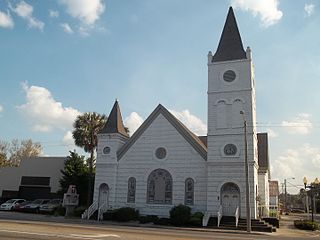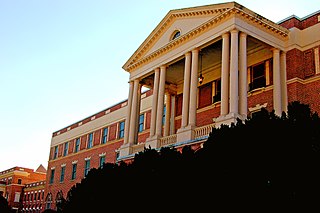
Georgetown is a historic neighborhood and commercial district in Northwest Washington, D.C., situated along the Potomac River. Founded in 1751 as part of the colonial-era Province of Maryland, Georgetown predated the establishment of Washington, D.C. by 40 years. Georgetown was an independent municipality until 1871 when the United States Congress created a new consolidated government for the entire District of Columbia. A separate act, passed in 1895, repealed Georgetown's remaining local ordinances and renamed Georgetown's streets to conform with those in Washington, D.C..

The black church is the faith and body of Christian denominations and congregations in the United States that predominantly minister to, and are also led by African Americans, as well as these churches' collective traditions and members. The term "black church" may also refer to individual congregations, including in traditionally white-led denominations.

Jackson Ward, previously known as Central Wards, is a historically African-American district in Richmond, Virginia, with a long tradition of African-American businesses. It is located less than a mile from the Virginia State Capitol, sitting to the west of Court End and north of Broad Street. It was listed as a National Historic Landmark District in 1978. "Jackson Ward" was originally the name of the area's political district within the city, or ward, from 1871 to 1905, yet has remained in use long after losing its original meaning.

Blackstone College for Girls was a private, religious school for young women in Blackstone, Nottoway County, in the U.S. state of Virginia. The school operated under the auspices of the Virginia Conference of the Methodist Episcopal Church, South between 1894 and 1950. The Virginia Department of Historic Resources acknowledged the significance of the site by erecting historical marker number K 174 in 1996. Blackstone College is also designated as a site on the Civil Rights in Education Heritage Trail. The school buildings still stand. Since 1955, the Virginia United Methodist Church has used the former school buildings as a conference center.

St. Joseph's African Methodist Episcopal Church is a historic African Methodist Episcopal church building located at Fayetteville Street and Durham Expressway in the Hayti District, now a neighborhood of Durham, Durham County, North Carolina.

Hayti, also called Hayti District, is the historic African-American community that is now part of the city of Durham, North Carolina. It was founded as an independent black community shortly after the American Civil War on the southern edge of Durham by freedmen coming to work in tobacco warehouses and related jobs in the city. By the early decades of the 20th century, African Americans owned and operated more than 200 businesses, which were located along Fayetteville, Pettigrew, and Pine Streets, the boundaries of Hayti.

Old Chapel is a historic Episcopal church building located near Millwood, Clarke County, Virginia. Old Chapel is now the oldest Episcopal church building still in use west of the Blue Ridge Mountains. It was listed on the National Register of Historic Places in 1973. In 2014, the Chapel Rural Historic District was recognized, and which encompasses both Cunningham parish churches, discussed below, as well as approximately 700 other structures and an area of nearly 10,500 acres.

The history of Alexandria, Virginia, begins with the first European settlement in 1695. Over the next century, the town became a significant port. In 1801, much of Alexandria was swept into the new District of Columbia; it was damaged along with much of the rest of the capital during the War of 1812. In 1846, Alexandria was returned to Virginia, along with the rest of the District's territory on the western side of the Potomac River. After Virginia seceded in 1861, Alexandria was swiftly captured by Union forces and held for the remainder of the American Civil War. In the late 20th century, Alexandria became a key part of the rapidly growing Northern Virginia region.
Alexandria, Virginia, an independent city in the Commonwealth of Virginia, is located along the western bank of the Potomac River. The city of approximately 151,000 is about six miles south of downtown Washington, D.C.
The following is a timeline of the history of the city of Durham, North Carolina, USA.

Saint Joseph Catholic Church is a predominantly Black Catholic church located at 711 N. Columbus St in historic Old Town Alexandria, Virginia. It was founded in 1916 to provide African-American parishioners of the local St. Mary's Roman Catholic Parish with their own church, freed from the customary restrictions that segregation imposed on them.

Robert H. Robinson (1824–1909) was a minister and an activist for the rights of African Americans during the Antebellum period in Arlington, Virginia. He was born into slavery, but through the negotiation by his grandmother, Caroline Branham, he was freed at age 21 after an eleven-year apprenticeship. He was a minister at Roberts Chapel, an African Methodist Episcopal Church. He established a night school and debate team for black freedman. The Robert H. Robinson Library was named in his honor.
Rev. Dr. Robert Simon Laws, a formerly enslaved person and Howard University graduate, founded two African American Baptist churches in the 19th century that have active congregations in the 21st century.

Meade Memorial Episcopal Church is a predominantly Black Episcopal Church in Old Town Alexandria, Virginia. Founded in 1870, the church today is supported by a congregation that includes descendants of the original founders of this parish. Meade Memorial belongs to the Episcopal Diocese of Virginia, whose members continue to serve the community and the Episcopal Church by participating in regional and Diocesan activities.

Shiloh Baptist Church is a predominantly Black Baptist Church at 1401 Duke Street in Old Town Alexandria, Virginia. At the time of its dedication in 1893, the historic building had a great bell tower, eight stained glass windows, modern circular oak pews, and a large reflector with glass prisms. While this historic building continues to be used as a youth center, the church has expanded to a large new sanctuary across Duke Street.

Mount Zion Baptist Church, established in 1866, is the oldest African American church in Arlington, Virginia. The church is a member of the National Baptist Convention USA and the Progressive National Baptist Convention.
William Augustus Hazel (1854–1929) was an American architect, stained glass artist, educator, academic administrator, and civil rights activist. He was the first dean of the Howard University School of Architecture in 1919. He is considered an important figure in the architectural history of the Twin Cities in Minnesota; and was one of the first Black stained glass artists in the United States.


















